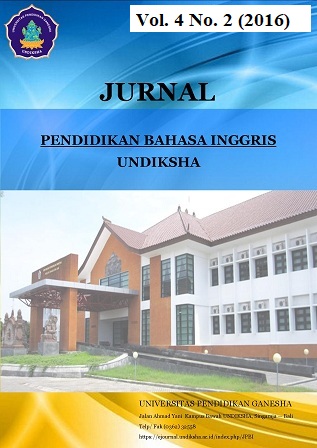ENGLISH USED BY STREET VENDORS IN BANJAR HOT SPRING, BALI
DOI:
https://doi.org/10.23887/jpbi.v4i2.8706Abstract
Penelitian ini bertujuan untuk mengetahui bentuk, fungsi bahasa dan faktor Bahasa inggris digunakan antara pedagang jalanan ketika mereka berkomunikasi dengan para wisatawan. Penelitian ini dilakukan di Banjar Hot Spring, Bali. Empat pedagang jalanan dipilih sebagai subyek penelitian ini berdasarkan kriteria. Penelitian ini adalah deskriptif kualitatif dimana data yang terkumpul dianalisis secara kualitatif. Peneliti adalah instrumen utama yang digunakan dalam penelitian ini. Dua perangkat yang digunakan oleh peneliti untuk mengumpulkan data, yaitu perekam video dan notetaking. Peneliti mengamati data dengan merekam percakapan yang dilakukan oleh subyek selama dua kali. Data ditranskrip dan dianalisis untuk mengetahui bentuk, fungsi bahasa dan faktor bahasa inggris. Hasil analisis data menunjukkan bahwa bentuk bahasa inggris yang digunakan antara pedagang jalanan adalah penyimpangan dari apa yang biasanya digunakan dalam hal tata bahasa, sintaksis, dan kosa kata dan juga ada beberapa komponen bahasa yaitu phonology, morphology, and syntax, Berdasarkan teori Spratt, Pulverness, dan Williams (2005: 17), ada tujuh fungsi bahasa yang digunakan antara pedagang jalanan ketika mereka berkomunikasi dengan wisatawan. Fungsi-fungsi Bahasa yang di maksud yaitu salam, menawarkan barang dan jasa, meminta pendapat, memberikan informasi, tidak setuju, berterima kasih, dan meninggalkan tempat yang digunakan antara pedagang jalanan, ada tujuh fungsi yang menjadi fokus penelitian ini.Kata Kunci : Bahasa Inggris, Pedagang jalanan, Bentuk, Fungsi Bahasa.
This study was aimed at finding out the forms, language function and factor of English used by the Street Vendors when they communicated with the tourists. This study was conducted at Banjar Hot Spring, Bali. Four street vendors were chosen as the subjects of this study based on the criteria. This study was descriptive qualitative in which the data collected were analyzed qualitatively. The researcher is the main instrument employed in this study. Two devices were used by the researcher to collect the data, namely video recorder and notetaking. The researcher observed the data by recording the conversation done by the subjects for two times. The data were transcribed and analyzed to find out the form, language function and factors of English. The result of the data analysis showed that the form of English used by the street vendors was a deviation from what is normally used in terms of grammar, syntax, and vocabulary and also some component of language such as phonology, morphology, and syntax. Based on the theory Spratt, Pulverness, and Williams (2005: 17), there are seven function of language used by Street Vendors when they were communicating with the tourist. Those language functions were greeting, offering goods and service, asking opinion, giving information, disagreeing, thanking, and leave-taking That is used by street vendors, there were seventh function that become the focus of this study.
keyword : English, Street Vendors, Form, Language Function.
Published
2016-11-02
Issue
Section
Articles
License
Authors who publish with the Jurnal Pendidikan Bahasa Inggris Undiksha agree to the following terms:- Authors retain copyright and grant the journal the right of first publication with the work simultaneously licensed under a Creative Commons Attribution License (CC BY-SA 4.0) that allows others to share the work with an acknowledgment of the work's authorship and initial publication in this journal
- Authors are able to enter into separate, additional contractual arrangements for the non-exclusive distribution of the journal's published version of the work (e.g., post it to an institutional repository or publish it in a book), with an acknowledgment of its initial publication in this journal.
- Authors are permitted and encouraged to post their work online (e.g., in institutional repositories or on their website) prior to and during the submission process, as it can lead to productive exchanges, as well as earlier and greater citation of published work. (See The Effect of Open Access)













